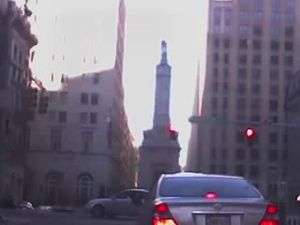St. Paul Street-Calvert Street
St. Paul Street and Calvert Street are a one-way pair of streets in Downtown Baltimore and areas north. The streets, which are part of Maryland Route 2, are two of Baltimore's best-known streets in the downtown area.
St. Paul Street
St. Paul Street begins off Charles Street just south of Coldspring Lane near Loyola College. From this point on, the street runs directly parallel to Charles Street, exactly one block east of Charles Street.
St. Paul Street is two ways until the intersection with 31st Street. Northbound traffic is relegated to a single northbound lane, separated by median, and with metered parallel parking.
St. Paul Street is exit 4 off the Jones Falls Expressway (I-83).
In the downtown area between East Centre and Lexington Streets, St. Paul Street is split into two parallel, nearby streets, also being identified as St. Paul Place in this area. The wider eastern thoroughfare was the former Courtland Street. While the more westward of the two intersects with all streets within these blocks, the eastward passes under the Orleans Street Viaduct (US 40). The area between the two St. Paul Streets, landscaped into terraced gardens and parks with fountains are known as Preston Gardens, replaced a group of 1820s Georgian, Federal and Greek Revival townhouses which had become shabby along Courtland Street and the original St. Paul Street and were razed in 1919 and was landscaped by Thomas Hastings.[1] The gardens are named after Baltimore politician James H. Preston, who was mayor of the City of Baltimore (1911-1919, and a Speaker in 1894 of the Maryland House of Delegates of which he served 1890-1894.
Notable landmarks
Calvert Street

As St. Paul Street is mostly one-way southbound, Calvert Street, which is directly east of St. Paul, is open to northbound traffic. North Calvert Street is a name of a portion of the street. South Calvert Street is a name for the downtown portion.
Calvert Street begins at Pratt Street near the Inner Harbor and continues through the downtown area and various north Baltimore neighborhoods before terminating in Guilford.
At its railroad crossing near I-83, Calvert Street once had an arch-style bridge, though not as interesting looking as the one on nearby Howard Street. The present crossing on Calvert Street is ordinary-looking.
Notable landmarks
Light Street
After passing Baltimore Street, St. Paul Street changes its name to Light Street. Light Street becomes a large, two-way street after passing Pratt Street, the point where Calvert Street begins for northbound traffic. Light Street continues through Key Highway, passing through Federal Hill and South Baltimore until its terminus at Wells Street.
Though quite short in length, Light Street is well known in the area, forming the western boundary of the Inner Harbor tourist area. The Maryland Science Center is located on Light Street, and the McCormick Spice Company between 1889 and 1989 was located on Light Street opposite the Inner Harbor.
Light Street is named for Darby Lux I, an early Baltimore merchant who had a house on the street.
References
- ↑ Power, Garrett (December 1983). "Apartheid Baltimore Style: The Residential Segregation Ordinances of 1910-1913". Maryland Law Review. 42: 289, 316.
External links
- Metal Arch Bridges in Maryland, Describes the history of the Calvert Street Bridge
- Historic American Landscapes Survey (HALS) No. MD-3, "Preston Gardens, St. Paul Place (St. Paul Street between Centre & Lexington Saratoga Streets), Baltimore, Independent City, MD", 2 photos, 1 photo caption page
Coordinates: 39°19′4″N 76°36′53.2″W / 39.31778°N 76.614778°W